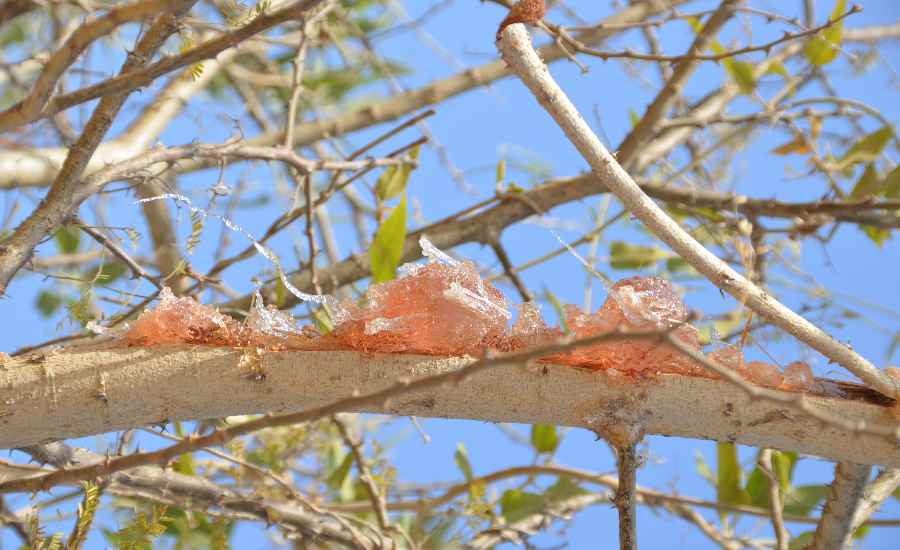Sticky business
On the trail of acacia gum: Part 3. How is an acacia orchard like a vineyard?
Alland & Robert can trace the ingredient to the plot where the gum was harvested.

A collector of gum takes a break from harvesting in the acacia tree plantation in Senegal.

After a harvester makes a superficial “scrape” along the trunk and branches, a tree's defense system exudes the gum just as our own bodies would send immune chemicals to the site of a new wound.

At an acacia tree nursery in Senegal, new trees are started and tended to until they are ready to be transplanted.

At the acacia tree nursery, women plant seeds. Later, the seedlings will be transplanted in the acacia tree plantation.

Author Kim Decker (kneeling, in cap) traveled to Senegal to visit acacia tree plantations that supply acacia gum to Alland & Robert, Paris. To Kim’s left is Myriam Brunel, the company’s quality-assurance director. Behind Myriam is Marketing Manager Violaine Fauvarque. CEO Frédéric Alland (a fifth-generation Alland) is in the pink shirt and straw hat. Alland & Robert underwrote the travel expenses.





[Editor’s note: Alland & Robert invited Dairy Foods Ingredients Editor Kimberly J. Decker to visit its acacia gum supplier in Senegal. In Part One, Kim described her 24-hour journey from San Francisco to Dakar, Senegal. In Part Two, she observed how harvesters carefully scrape the tree trunks and branches, which prompts the acacia to exude the gum. In the final part of her blog, she learns that the gum’s emulsifying capacity depends, in part, upon terroir.]
After selecting and harvesting the crude gum, the workers collect the nodules and carry them back to the farmhouse for the subsequent steps of kibbling—breaking apart larger chunks into smaller ones—light cleaning of field debris and preliminary sorting and drying before shipment to the sorting facility that we’d visited the previous day.
Tracing the gum back to the plot
And at every step in the process—from collection in the orchard to bagging at the final facility—the Asilya and Ferlo crew tracks each particular of the gum’s path. As Myriam Brunel, the company’s quality director, explained, maintaining a complete and fully traceable account of details like the plot where the gum was harvested, the harvest date and the prevailing weather conditions at the time is essential because such details influence how the gum performs functionally in applications.
For example, back in France at Alland & Robert’s R&D lab, a team of food scientists led by Isabelle Jaouen, the company’s lab director, works with universities and research institutions to elucidate what makes acacia gum special, and how its growth and harvest conditions affect its functionality.
Among the insights they’ve gained is that a gum’s emulsifying capacity depends, in part, on its country of origin and the soil composition in which it grew. Gum from Senegal’s sandy soils, it turns out, maintains emulsion stability better than gum from trees growing in clay-based soil. The lesson is that by knowing the path a gum followed from farm to factory, Alland & Robert can better predict what sort of ingredient it’ll be.
Acacia gum quality is linked to terroir
Anyone who’s read even lightly on viticulture will observe that similar conditions influence the quality of wine grapes—sandy soils versus clay; sunny slopes versus shady ones. It’s all about the terroir, right? And sure enough, Asilya growers even selectively graft high-performing rootstock onto trees to improve output, much as wine-grape growers do. So it seemed rather fitting that a parallel would emerge between France’s iconic wine grapes and this agricultural product that a French firm now sources from African partners.
I reflected on all this as I flew back to SFO, my shiny nodule of acacia gum tucked deep within my carry-on bag so as not to attract the prying eyes of the Customs and Border Protection officers. And I thought about something, else, too: Violaine Fauvarque, Alland & Robert’s marketing manager, mentioned that the more we learn about acacia gum, the more we realize how much more there is to learn. After spending two days in Senegal getting a small taste of what’s out there, I can’t wait to find out more.




